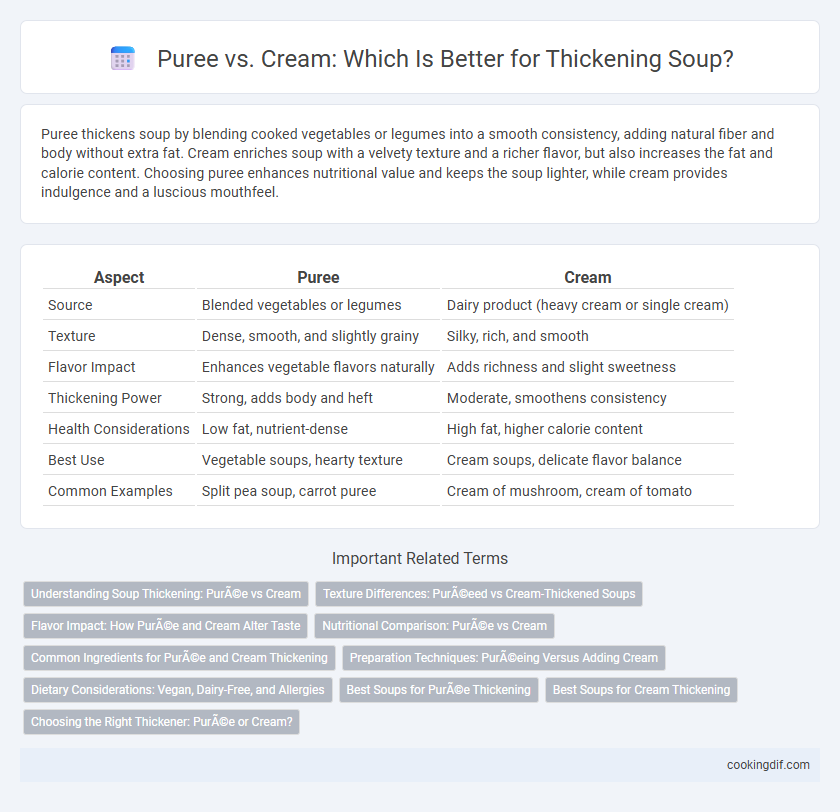Puree thickens soup by blending cooked vegetables or legumes into a smooth consistency, adding natural fiber and body without extra fat. Cream enriches soup with a velvety texture and a richer flavor, but also increases the fat and calorie content. Choosing puree enhances nutritional value and keeps the soup lighter, while cream provides indulgence and a luscious mouthfeel.
Table of Comparison
| Aspect | Puree | Cream |
|---|---|---|
| Source | Blended vegetables or legumes | Dairy product (heavy cream or single cream) |
| Texture | Dense, smooth, and slightly grainy | Silky, rich, and smooth |
| Flavor Impact | Enhances vegetable flavors naturally | Adds richness and slight sweetness |
| Thickening Power | Strong, adds body and heft | Moderate, smoothens consistency |
| Health Considerations | Low fat, nutrient-dense | High fat, higher calorie content |
| Best Use | Vegetable soups, hearty texture | Cream soups, delicate flavor balance |
| Common Examples | Split pea soup, carrot puree | Cream of mushroom, cream of tomato |
Understanding Soup Thickening: Purée vs Cream
Puree thickens soup by blending cooked vegetables or legumes into a smooth consistency, adding natural fiber and nutrients while enhancing flavor depth. Cream increases richness and smoothness through dairy fat, creating a velvety texture but also raising calorie content. Choosing puree supports a lighter, heartier soup, whereas cream delivers a more indulgent, silky finish.
Texture Differences: Puréeed vs Cream-Thickened Soups
Pureeed soups achieve thickness by blending vegetables or legumes into a smooth, dense consistency, resulting in a hearty and substantial texture. Cream-thickened soups rely on dairy or substitutes like heavy cream or coconut milk, creating a rich, velvety mouthfeel that is lighter and silkier than purees. The choice between puree and cream dramatically influences the tactile experience, with puree emphasizing body and density while cream enhances smoothness and richness.
Flavor Impact: How Purée and Cream Alter Taste
Puree intensifies soup flavor by concentrating natural ingredients, adding a robust and fresh taste profile, while maintaining nutritional benefits and texture complexity. Cream introduces a rich, smooth mouthfeel with subtle sweetness, softening spices and balancing acidity without overpowering base flavors. Choosing puree enhances depth and freshness, whereas cream provides a luxurious, mellow finish.
Nutritional Comparison: Purée vs Cream
Puree-based soups typically offer higher fiber content and increased vitamins due to the blending of whole vegetables, making them a nutrient-dense option. Cream thickeners add richness and smooth texture but contribute significant saturated fats and calories, which can impact heart health if consumed in excess. Choosing puree over cream enhances the soup's nutritional profile with lower fat and higher dietary fiber, promoting better digestion and overall wellness.
Common Ingredients for Purée and Cream Thickening
Puree thickening in soups often relies on common ingredients such as cooked vegetables, legumes, or potatoes, which are blended to create a smooth, dense texture while enhancing natural flavors and nutritional value. Cream thickening typically involves dairy products like heavy cream, half-and-half, or milk, contributing to a rich, velvety consistency and adding subtle sweetness and fat content. Both methods provide unique textures and mouthfeel, with purees offering fiber and body, and creams delivering smoothness and richness in soup recipes.
Preparation Techniques: Puréeing Versus Adding Cream
Pureeing soup involves blending cooked vegetables or legumes until smooth, which naturally thickens the soup by incorporating fiber and starches, enhancing both texture and nutritional content. In contrast, adding cream thickens the soup by increasing its fat content, resulting in a richer, silkier mouthfeel but without altering the fiber structure. Preparation techniques for pureeing often require a blender or immersion blender to achieve a consistent texture, while cream is simply stirred in near the end of cooking to avoid curdling.
Dietary Considerations: Vegan, Dairy-Free, and Allergies
Puree thickening in soup uses blended vegetables or legumes, making it naturally vegan, dairy-free, and hypoallergenic, ideal for those with dairy sensitivities or egg allergies. Cream thickening relies on dairy products, which can trigger lactose intolerance or milk protein allergies and excludes vegan diets. For dietary flexibility, puree offers a nutrient-dense alternative that avoids common allergens found in traditional cream-based soups.
Best Soups for Purée Thickening
Puree thickening works best in vegetable-based soups such as butternut squash, tomato bisque, and carrot ginger, where the natural fibers create a smooth, velvety texture without added dairy. This method enhances the soup's nutritional profile by retaining fiber and vitamins while providing a rich consistency. Pureeing also complements rustic and hearty soups, maintaining authentic flavors and a wholesome mouthfeel.
Best Soups for Cream Thickening
Cream thickening enhances soups like bisques, chowders, and veloutes by adding a rich, velvety texture and smooth finish. Unlike puree, which uses blended vegetables or legumes to increase body, cream adds a subtle sweetness and depth without altering the flavor profile drastically. Ideal soups for cream thickening include clam chowder, tomato bisque, and creamy mushroom soup due to their complementary flavors and luxurious consistency.
Choosing the Right Thickener: Purée or Cream?
Puree thickens soup by blending cooked vegetables or legumes, enhancing texture and flavor naturally without adding dairy. Cream adds rich, smooth consistency and a luxurious mouthfeel but also increases fat and calorie content. Choosing between puree and cream depends on dietary preferences and the desired balance of flavor and nutritional profile in the soup.
Purée vs Cream for thickening Infographic

 cookingdif.com
cookingdif.com